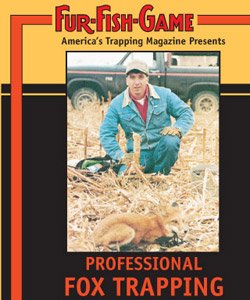This site is supported by you, the reader. If you make a purchase through one of my links, I may earn a small commission. Learn more here.
Reprinted from the January 2017 issue of the Northwoods Sporting Journal
Like many other trappers, a big part of my early trapping education came from the Fur-Fish-Game video library series on trapping. From 1985-1992, professional trapper Tom Miranda produced eight trapping videos geared toward educating trappers looking to get into the profession. It was a good time in the trapping world. Fur prices were higher and expenses were lower than they are today. A hardworking youngster could actually make a go of it as a pro trapper.
In today’s world it’s difficult to imagine making anywhere near a living wage trapping. Fur prices are at historic lows for most species. Back in the day, Miranda was traveling all over the country running traplines for multiple species and making good money. Let’s take a look at today’s prices for fur and imagine what you’d have to do to ‘make it’ as a professional trapper.
Using Maine as an example, let’s see what a skilled, full time trapper might be able to make in the fur check.
Beaver – With a high beaver population a hard working trapper can clean up in Maine, and some do. Several trappers have teamed up and caught more than 150 beavers each. But the historic averages of $50 per beaver are gone, and in good years the market might give you $25. Last year beavers averaged less than $10. Let’s say our pro trapper did well and also marketed the castor and carcasses. A $20 average would bring about $3,000.
Mink – In very few recent years have mink averaged more than $10 each. Let’s say our trapper runs a long mink line, hitting the road crossings and culverts, and catches 100 mink for $1000.
Muskrat – ‘rats are easy to catch if you can find them. A good trapper who focuses solely on rats for a period of time in good habitat might be able to catch 1000. At recent averages that’s about $3,000.
Fox/Coyote – Maine coyotes aren’t as valuable as the pale western dogs, but there has been a market for them. Long term average is probably about $25 each, and a hardworking coyote trapper could catch 100, for $2,500. Where you find lots of coyotes, foxes won’t be as plentiful, but let’s say we found 50 at a generous $30 each, for another $1,500.
Raccoon – you can’t give away coon skins right now, but if the market comes back they might fetch $10 or a bit more. 50 coons for $500 is a reasonable target.
Marten and Fisher – Maine trappers are limited to a quota of 25 marten and 10 fisher. In a good year our marten may bring $50 or so. If we caught 20 at this price, we’re looking at $1,000. Add 10 fisher at $50 for $500.
Other species – Otter, weasels and skunks will bring a few bucks as well, but big numbers and big prices are few and far between for these. Let’s add in another $200. We won’t even mention bobcats. Lynx are far more common than bobcats in the northern half of Maine, and trappers are doing their best to avoid these federally protected ‘cats that seem more common than coyotes in some townships.
With today’s prices, our modern trapper grosses a little over $13,000. When we consider the fuel, vehicle wear and tear, equipment and other miscellaneous expenses required to catch 150 beaver, 100 mink, 1,000 muskrats, 100 coyotes, 50 fox, 50 coons, 20 marten, 10 fisher and miscellaneous other critters, there isn’t much left. Plus, all that fur needs to be skinned, stretched, fleshed and dried, then sent to a very risky and volatile fur market. It’s clear that pro fur trapping is a thing of the past.
Despite the lack of a fur market that pays a livable wage, thousands of trappers are out pursuing fur every fall and winter throughout most U.S. states. That’s because for most folks, trapping is about more than just a fur check. It’s similar to the reason deer hunters spend far more money on each pound of venison in the freezer than they could justify spending for beef at the store. In addition, trapping plays a critical role in the management of healthy furbearer populations nationwide, preventing the spread of disease, habitat destruction and human-animal conflicts.
Even with low fur prices, some passionate trappers still make a living in the profession. Many are animal damage control agents for state/federal agencies or private companies. Some offer trapping instruction, write books, make videos, and manufacture and sell trapping lures and supplies.
No, it’s not easy to be a professional fur trapper these days, but for many young folks the dream is still there. You can still buy Tom Miranda’s pro trapping videos from Fur-Fish-Game magazine. They continue to inspire young trappers, and remind old timers of the fur boom days when teenagers could make more money than their parents during trapping season.
As for Miranda? He moved on to bowhunting.

Where can I sell fox pelts on NJ?
https://www.zanderfur.com/